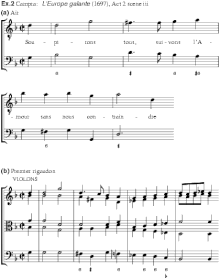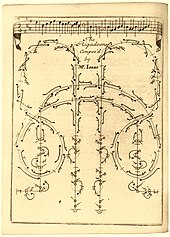Rigaudon

The or rigaudon (rarely also: Rigodon; in Germany: Rigadon or Riguadon; Engl .: Rigadoon or Riggadoon) is an old French court and ballroom dancing , the end of the 17th century from folk dances of the Provence and Languedoc emerged, and Found entry into ballet , opera and instrumental suite .
history
Although the origin of the word is not exactly clear, a connection with French " rigoler " - joking, having fun, having a good time is suspected. An origin from the Latin "gaudium" - joy, pleasure is possible (this is also in the Bavarian word "a Gaudi"). On the one hand, these derivations are interrelated and, on the other hand, they also correspond to the happy, lively character of the dance. Rousseau reports (by hearsay) in his Dictionnaire de la Musique in 1768 that the dance may have been named after its inventor, a gentleman named Rigaud .
The Rigaudon as a cultivated court dance gradually went out of fashion in the second half of the 18th century, but was still extremely popular in the south of France as a cheerful folk dance from the end of the 18th century until the First World War. During this time it was considered a typical Dauphiné dance .
After a phase of decline, there has been a revival since around 1968, and in the 21st century folk Rigaudons are being cultivated again, which are not infrequently demanding and sporty for the dancers. Outside France, the popular French rigaudon has spread to Canada, in the Québec region . There is a popular ballroom dance in the Philippines called Rigodon de Honor , but it is slower than the French dances.
description
The Rigaudon is a row and couple dance in the very lively 2/2 or alla-breve time (also 2/4 or 4/4) with a predominant regular and hopping quarter and eighth movement, and with a beginning of a quarter. There are close relationships (as Johann Mattheson noted in 1739) above all to the Bourrée , and also to the much more noble Gavotte .
Compared to the bourrée, the quarter opener is typically followed by two or three beats of half notes in many Rigaudons , only then does the actual movement begin, e.g. B. in Rigaudon from André Campras L'Europe galante (1697). Similar two to three half-note beats can also occur in the further course of a piece, also towards the end, often in the penultimate measure of a phrase (e.g. with Johann Caspar Ferdinand Fischer ). In some cases they take place in other and less conspicuous places at all, for example in a famous Riggadoon in C by Henry Purcell they appear initially only in the bass, then twice in the second part towards the end of the phrase. Handel banned the halves in Rigaudon I of his Wassermusik to the second bar, but the accompanying Rigaudon II has them in the usual place at the beginning, in the first bar. In the 18th century, French composers such as François Couperin or Jean-Philippe Rameau also wrote Rigaudons in which the typical features of half-strokes are completely omitted (e.g. in Rameau's Dardanus 1739). Such pieces seem to be more inspired by French folk music, they are musically mostly simple, and are based almost exclusively on regular quarter (or eighth) movement.
The coupling of Rigaudon I and II is quite common; the typical characteristics of the Rigaudon II are sometimes less pronounced, and it functions more as a contrasting trio , e.g. B. in J. C. F. Fischer's harpsichord suites Terpsichore and Uranie ( Musicalischer Parnassus 1738).
A hopping dance step, the so-called pas de rigaudon, is named after the Rigaudon .
Web links
Videos on YouTube :
- Baroque dance: Rigaudon de Provence, with Adeline Lerme & Bruno Benne (visited on July 29, 2017)
- French folk dance 1: Le Rigodon (visited on July 29, 2017)
- French folk dance 2: Rigodon Cuquois , danced by the Confrérie des vins de Visan (dance starts at 1.58 min!) (visited on July 29, 2017)
swell
literature
- Jean-Michel Guilcher, "Le domaine du rigodon: une province originale de la danse", in: Le monde alpin et rhodanien , n ° 1-2 ( Chants et danses de tradition ). Grenoble, Center alpin et rhodanien d'Ethnologie, 1984.
- Meredith Ellis Little: "Rigaudon", in: The New Grove Dictionary of Music and Musicians , second edition, ed. By Stanley Sadie & John Tyrrell, London: Macmillan Publishers 2001.
- Konrad Ragossnig: Manual of the guitar and lute . Schott, Mainz 1978, ISBN 3-7957-2329-9 .
- Petit Robert 1 - Dictionnaire de la langue francaise , par Paul Robert, rédaction dirigée par A. Rey & J. Rey-Debove, Dictionnaires Le Robert, Paris 1987.
grades
- François Couperin, Pièces de Clavecin , 4 vols., Ed. by Jos. Gát, Mainz et al .: Schott, 1970–1971.
- Johann Caspar Ferdinand Fischer, Musical Parnassus (1738?), In: Complete Works for Keyboard Instrument , ed. v. Ernst von Werra, Wiesbaden: Breitkopf & Härtel, (originally 1901).
- Henry Purcell, Piano Solo Complete Edition (Urtext) , ed. By István Máriássy, Budapest: Könemann (n.d.).
- Jean-Philippe Rameau, Pièces de Clavecin (Complete Edition), ed. by ER Jacobi, Kassel et al .: Bärenreiter, 1972.
Recordings
- Handel, Telemann - Watermusic , The King's Consort, Robert King, published by: Hyperion, CDA66967 (rec. 1997) (CD).
Individual evidence
- ↑ Brockhaus (1809) .
- ^ According to the French linguistic dictionary Petit Robert 1 , the word " rigoler " first appeared in a text in 1650; “ Se rigoler ” as early as the 13th century. See: Petit Robert 1 - Dictionnaire de la langue francaise , par Paul Robert, rédaction dirigée par A. Rey & J. Rey-Debove, Dictionnaires Le Robert, Paris 1987, p. 1718.
- ↑ “ ... J'ai ouï dire à un maitre à Danser, que le nom de cette danse venoit de celui de l'inventeur, lequel s'appeloit Rigaud ”. See: Jean-Jacques Rousseau, Rigaudon , in: Dictionnaire de musique , Paris 1768, p. 426.See also on IMSLP , accessed August 12, 2017.
- ↑ Jean-Michel Guilcher, “Le domaine du rigodon: une province originale de la danse”, Le monde alpin et rhodanien . Grenoble, Center alpin et rhodanien d'Ethnologie, 1984, n ° 1-2 consacré aux Chants et danses de tradition .
- ^ Konrad Ragossnig : Handbook of the guitar and lute. Schott, Mainz 1978, ISBN 3-7957-2329-9 , p. 115 ("Incidentally, the Rigaudon is a true hybrid, composed of Gavot and Bourrée and could not be called a quadruple Bourrée").
- ↑ Johann Caspar Ferdinand Fischer, Musikalischer Parnassus (1738?), In: Complete works for keyboard instrument , ..., Wiesbaden: Breitkopf & Härtel (originally 1901), p. 58 (Terpsichore) and p. 68-69 (Uranie) .
- ↑ The piece Riggaudoon also has, atypically, no prelude. See: Henry Purcell, Piano Solo Complete Edition (Urtext) , ed. By István Máriássy, Budapest: Könemann (n.d.), pp. 42–43.
- ^ François Couperin, Pièces de Clavecin , Vol. 1, ..., Mainz et al .: Schott, 1970–1971, Vol. 1, pp. 51–52. And: Jean-Philippe Rameau, Pièces de Clavecin (Complete Edition), ..., Kassel et al .: Bärenreiter, 1972, pp. 30–31.
- ↑ Johann Caspar Ferdinand Fischer, Musikalischer Parnassus (1738?), In: Complete works for keyboard instrument , ..., Wiesbaden: Breitkopf & Härtel (originally 1901), p. 58 (Terpsichore) and p. 68-69 (Uranie) .
